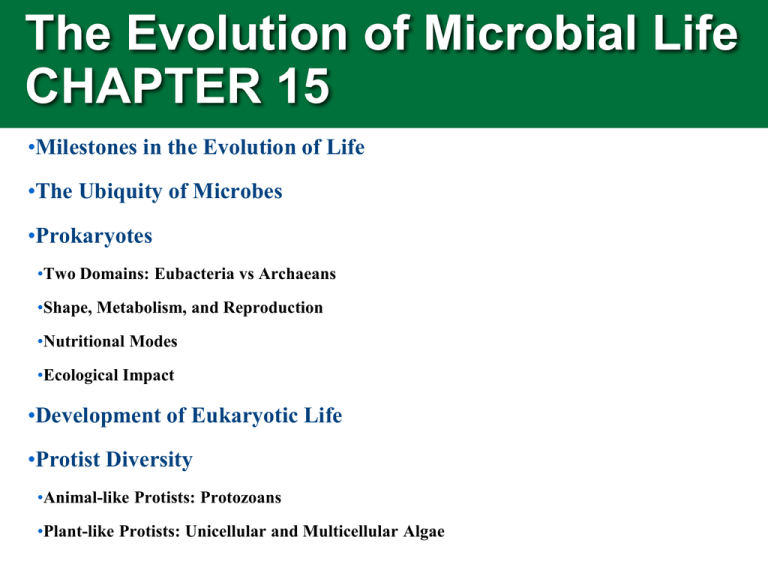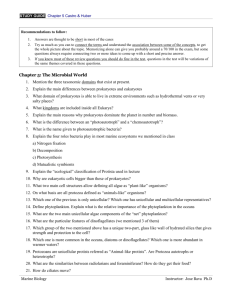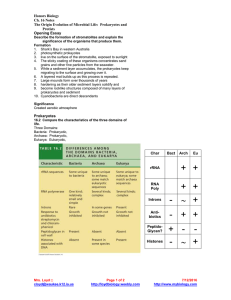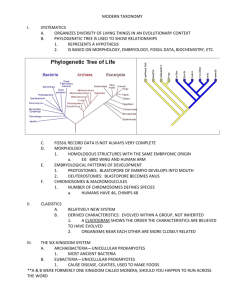The Evolution of Microbial Life CHAPTER 15 •
advertisement

The Evolution of Microbial Life CHAPTER 15 •Milestones in the Evolution of Life •The Ubiquity of Microbes •Prokaryotes •Two Domains: Eubacteria vs Archaeans •Shape, Metabolism, and Reproduction •Nutritional Modes •Ecological Impact •Development of Eukaryotic Life •Protist Diversity •Animal-like Protists: Protozoans •Plant-like Protists: Unicellular and Multicellular Algae Major Episodes in the History of Life • Prokaryotes appeared about 3.5 billion years ago. • Oxygen production began about 2.5 billion years ago. • Single-celled eukaryotic organisms evolved about 2.2 billion years ago. • Multicellular eukaryotes evolved about 1 billion years ago. • All the major phyla of animals evolved by the end of the Cambrian explosion, which began about 540 million years ago. • About 475 million years ago: – Plants and fungi colonized land. – Amphibians evolved from fish, and vertebrate life moved onto land. The Origin of Life and the First Cells • Most biologists now think it is possible that chemical and physical processes on the early Earth produced simple cells. – Stage 1: Abiotic Synthesis of Organic Monomers – Stage 2: Abiotic Synthesis of Polymers – Stage 3: Origin of SelfReplicating Molecules – Stage 4: Formation of Pre-Cells The Primordial Soup Figure 15.4b Enclosed Structures – Pre-Cells? From Chemical Evolution to Darwinian Evolution • • Over millions of years, – Natural selection favored the most efficient pre-cells. – The first prokaryotic cells evolved. Prokaryotes – Lived and evolved all alone on Earth for 2 billion years. The Evolution of Microbial Life CHAPTER 15 •Milestones in the Evolution of Life •The Ubiquity of Microbes •Prokaryotes •Two Domains: Eubacteria vs Archaeans •Shape, Metabolism, and Reproduction •Nutritional Modes •Ecological Impact •Development of Eukaryotic Life •Protist Diversity •Animal-like Protists: Protozoans •Plant-like Protists: Unicellular and Multicellular Algae Characteristics of Prokaryotes • They’re everywhere! – Prokaryotes far outnumber the eukaryotes and are found in soil, water, air, and inside other living things – Most are beneficial or neutral to humans, a small percentage cause disease • The majority of known prokaryotes belong to Domain Eubacteria • The Archaeans (Domain Archaea) are often extremophiles – Halophiles thrive in salty environments. – Extreme thermophiles live in hot springs or vents Hydrothermal Vent – Methanogens inhabit the bottoms of lakes and swamps. The Structure, Function, and Reproduction of Prokaryotes • Prokaryotic cells – Lack true nuclei, membrane-enclosed organelles, and have cell walls of murein or pseudomurein • Prokaryotes come in several shapes: – Spherical (cocci) – Rod-shaped (bacilli) – Spiral (spirochetes) • Most prokaryotes are unicellular and very small (1-10 um) The Structure, Function, and Reproduction of Prokaryotes • Some prokaryotes are large, can perform photosynthesis, or can form colonies • About half of all prokaryotes can move by means of one or more flagella • Some prokaryotes form endospores that can survive harsh conditions (chemicals & radiation) • Most prokaryotes can reproduce by binary fission at very high rates if conditions are favorable. Cyanobacteria) The Evolution of Microbial Life CHAPTER 15 •Milestones in the Evolution of Life •The Ubiquity of Microbes •Prokaryotes •Two Domains: Eubacteria vs Archaeans •Shape, Metabolism, and Reproduction •Nutritional Modes •Ecological Impact •Development of Eukaryotic Life •Protist Diversity •Animal-like Protists: Protozoans •Plant-like Protists: Unicellular and Multicellular Algae Four Modes of Nutrition Seen in Prokaryotes Includes photosynthetic cyanobacteria like Oscillatoria Table 15.1 Some Bacteria Are Pathogenic (Disease-Causing) • Bacteria are successful when invading host organisms by producing poisonous exotoxin proteins or containing endotoxins within their cells walls • Examples of human bacterial diseases include Lyme Disease, tuberculosis, botulism, tetanus, gangrene, shigellosis, and “strep” throat • The best defenses against bacterial disease are: sanitation, antibiotics, and education. • Using antibacterial products everywhere in the home is not the answer! Prokaryotes Have a Huge Ecological Impact • Prokaryotes are essential to chemical cycling and decomposition of dead organisms • Without prokaryotes, new life would not be possible Industrial Applications of Bacterial Growth in Society Using bacteria to decompose human sewage Using bacteria to break down oil after an oilspill The Evolution of Microbial Life CHAPTER 15 •Milestones in the Evolution of Life •The Ubiquity of Microbes •Prokaryotes •Two Domains: Eubacteria vs Archaeans •Shape, Metabolism, and Reproduction •Nutritional Modes •Ecological Impact •Development of Eukaryotic Life •Protist Diversity •Animal-like Protists: Protozoans •Plant-like Protists: Unicellular and Multicellular Algae Eukaryotes Evolved From Prokaryotes Figure 15.18 The Evolution of Microbial Life CHAPTER 15 •Milestones in the Evolution of Life •The Ubiquity of Microbes •Prokaryotes •Two Domains: Eubacteria vs Archaeans •Shape, Metabolism, and Reproduction •Nutritional Modes •Ecological Impact •Development of Eukaryotic Life •Protist Diversity •Animal-like Protists: Protozoans •Plant-like Protists: Unicellular and Multicellular Algae Protists (Kingdom Protista) • Protists – Are eukaryotic – Mostly unicellar but some multicellular – Categorized by nutritional modes • Animal-like protists called protozoans ingest food • Plant-like protists called algae use sunlight Protozoans • Protozoans (Animal-like protists) categorized by how they move – Flagellates move by means of flagella (e.g. trypanosomes) – Amoebas move by means of pseudopodia (e.g. foraminifera and radiolarians in ocean plankton) – Ciliates move by means of cilia (e.g. Paramecium, Vorticella) Euglena Motion Amoeba Pseudopodia Vorticella Cilia Paramecium Cilia The Evolution of Microbial Life CHAPTER 15 •Milestones in the Evolution of Life •The Ubiquity of Microbes •Prokaryotes •Two Domains: Eubacteria vs Archaeans •Shape, Metabolism, and Reproduction •Nutritional Modes •Ecological Impact •Development of Eukaryotic Life •Protist Diversity •Animal-like Protists: Protozoans •Plant-like Protists: Unicellular and Multicellular Algae Algae • Algae (Plant-like Protists) – Subdivided into unicellular and multicellular – Unicellular algaes (often found in plankton) • Diatoms • Dinoflagellates • Colonial Algae (e.g. Volvox) – Multicellular algae (seaweeds) Volvox Colony • Large, multicellular, marine • Classified by photosynthetic pigments : green, red, & brown Biology and Society: Bioterrorism • During the fall of 2001, five Americans died from the disease anthrax in a presumed terrorist attack. • Microbes can be used as weapons The Evolution of Microbial Life CHAPTER 15 •Milestones in the Evolution of Life •The Ubiquity of Microbes •Prokaryotes •Two Domains: Eubacteria vs Archaeans •Shape, Metabolism, and Reproduction •Nutritional Modes •Ecological Impact •Development of Eukaryotic Life •Protist Diversity •Animal-like Protists: Protozoans •Plant-like Protists: Unicellular and Multicellular Algae








